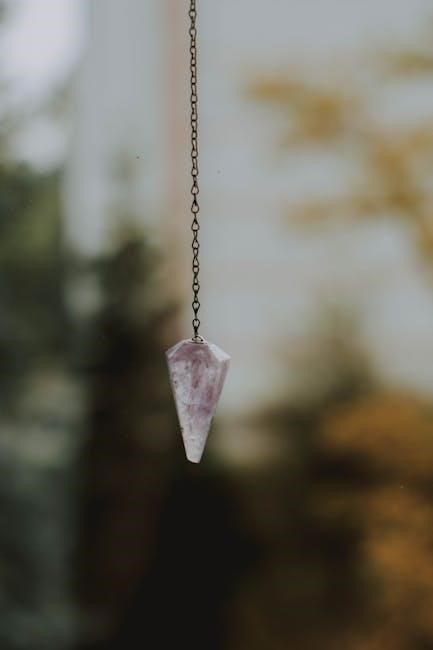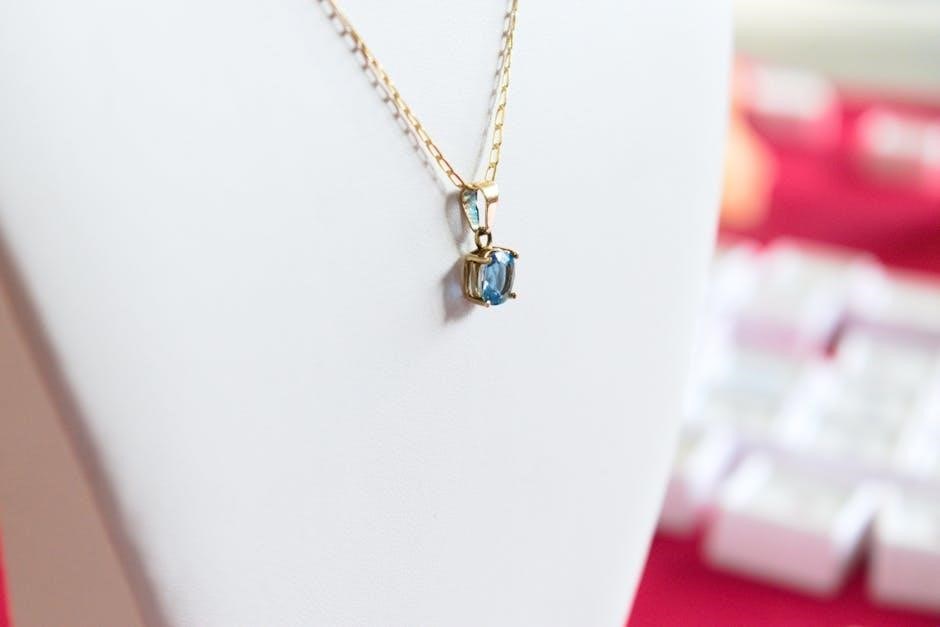The Byzantine chain, a popular chain maille weave, offers versatility and elegance, making it ideal for crafting jewelry like necklaces and bracelets. Its intricate design, while visually striking, is surprisingly accessible for both beginners and experienced crafters. By following detailed step-by-step instructions, anyone can master this timeless technique, creating beautiful and durable pieces.
Overview of the Byzantine Chain Weave
The Byzantine Chain Weave is a popular and elegant chain maille pattern, ideal for creating durable and visually striking jewelry. It involves connecting jump rings in a specific sequence, forming interconnected units that create a flexible and reversible design. This weave is characterized by its alternating direction of rings, achieved through the use of connector rings that reverse the orientation of each subsequent unit. The Byzantine Chain is versatile and can be adapted to various projects, making it a favorite among crafters. Its intricate yet symmetrical appearance adds sophistication to necklaces, bracelets, and other decorative items, while its construction remains accessible to both beginners and experienced artisans.
Importance of Following Detailed Instructions
Following detailed instructions is crucial when crafting the Byzantine Chain to ensure a flawless and professional finish. Properly closing jump rings and maintaining the correct sequence prevents misalignment and structural weakness. Accurate steps guarantee the chain’s flexibility and aesthetic appeal, essential for jewelry-making. Even minor errors can disrupt the entire design, making meticulous adherence to instructions vital for success; By carefully following each step, crafters can achieve a durable, elegant piece that withstands wear, making the effort worthwhile for both beginners and experienced artisans alike.

Materials and Tools Required
Crafting a Byzantine chain requires jump rings in various sizes, sturdy pliers, wire cutters, and a stable work surface for organizing and shaping the design.
Jump Rings: Sizes and Types
Jump rings are the foundation of the Byzantine chain, requiring careful selection by size and type. Commonly, 18-gauge jump rings with an inner diameter of 3.5mm are recommended for durability and flexibility. The size of the jump rings will dictate the overall texture and drape of the chain. Smaller rings create a tighter weave, while larger ones produce a bolder, more open design. Jump rings can be made from various materials, including silver-filled, gold-plated, or stainless steel, each offering different aesthetic and durability options. Properly closing jump rings is essential for the chain’s structural integrity. Using consistent sizes ensures a uniform and professional finish.
Essential Tools for Crafting the Byzantine Chain
Crafting the Byzantine chain requires specific tools to ensure precision and ease. Flat-nose pliers are indispensable for opening and closing jump rings securely. A sturdy work surface, such as an anvil or mandrel, helps shape and align rings evenly. Optional tools include a jump ring opener for efficiency and a polishing cloth for finishing touches. These tools collectively enable artisans to create intricate, professional-quality Byzantine chains with ease and accuracy.

Step-by-Step Guide to Making the Byzantine Chain
Start with two jump rings, then add closed rings and connector rings to form the foundation. Reverse the chain direction to create the signature interlocking pattern.
Step 1: Starting with Two Jump Rings
Begin by selecting two jump rings of the same size and type. Open one jump ring slightly using flat-nose pliers, ensuring it is just enough to accommodate another ring. Thread the second jump ring through the opened one, then carefully close it to secure. This initial connection forms the base of the Byzantine chain. Properly aligning and closing the rings is crucial for stability and appearance. Make sure both rings lie flat and even, setting a solid foundation for the subsequent steps in the weaving process.
Step 2: Adding Closed Jump Rings

With the initial two jump rings connected, proceed to add two closed jump rings to one of the open rings. Open one jump ring slightly and thread it through the two closed rings, ensuring they are properly aligned. Close the jump ring securely using flat-nose pliers to maintain even tension. This step establishes the foundation for the Byzantine pattern, where each subsequent ring builds on the previous connection. Be careful not to misalign the rings, as this could disrupt the chain’s structural integrity. Properly closing the jump rings is essential for a smooth and durable finish, setting the stage for the next steps in the weaving process.
Step 3: Incorporating Connector Rings
To incorporate connector rings, open one jump ring and thread it through the two closed rings from the previous step. Close the connector ring firmly, ensuring it sits snugly between the rings. This step reverses the direction of the chain, creating the signature Byzantine weave pattern. Repeat this process, alternating the direction of the chain with each connector ring added. Properly closing each connector ring is crucial to maintain the chain’s structural integrity and aesthetic appeal. This step requires precision to ensure the rings align correctly, forming the intricate design that defines the Byzantine chain. Keep the chain flat to maintain proper alignment as you progress.

Step 4: Reversing the Direction of the Chain
To reverse the chain’s direction, open a new jump ring and thread it through the last two rings in the current segment. Close the ring securely, ensuring it locks into place. This action flips the chain’s orientation, allowing the pattern to continue in the opposite direction. Repeat this step to maintain the weave’s consistency. Proper alignment is key to achieving the Byzantine chain’s characteristic flow. By reversing the direction methodically, you ensure the chain remains balanced and visually appealing. This step is vital for creating the intricate, interconnected design that defines the Byzantine weave.

Advanced Techniques in Byzantine Chain Weaving
Explore intricate variations by experimenting with different metals, colors, and sizes. Create graduated chains or incorporate unique connectors for a personalized, sophisticated design that elevates your craftsmanship.
Creating a Graduated Byzantine Jump Ring Chain
A graduated Byzantine chain adds visual interest by varying jump ring sizes. Start with smaller rings at the center and gradually increase size towards the ends. This technique creates a dynamic, eye-catching piece. To achieve this, begin by weaving the base chain with uniform rings. Once the foundation is set, introduce larger rings on one end, carefully integrating them into the existing pattern. Repeat on the opposite side, ensuring symmetry. This method allows for a seamless transition between sizes, enhancing the chain’s appeal. Practice and patience are key to mastering this advanced yet rewarding variation of the Byzantine weave.
Using Different Materials for Unique Designs
Exploring various materials can elevate your Byzantine chain creations. Silver, gold, and copper are popular choices, but experimenting with colored rings or mixed metals adds a modern twist. For a rustic look, try brass or bronze. Leather or fabric strips woven into the chain offer a bohemian flair. Even plastic or nylon rings can create lightweight, budget-friendly designs. Combining different textures, like smooth and hammered rings, enhances visual appeal. Alternatively, incorporate beads or gemstones for added sparkle. The key is to balance aesthetics with durability, ensuring the chosen materials complement the chain’s structure while maintaining its integrity and beauty. This versatility allows for truly one-of-a-kind designs.
Tips for Success and Common Mistakes
Ensure jump rings are fully closed to avoid gaps. Maintain consistent tension to prevent misalignment. Practice patience, as rushing leads to errors. Avoid over-tightening, which can distort the chain.
Ensuring Proper Closure of Jump Rings
Properly closing jump rings is crucial for a durable and professional-looking Byzantine chain. Begin by selecting high-quality jump rings with a smooth interior to prevent scratching. To close them securely, use flat-nose pliers to grip each side firmly. Apply gentle, consistent pressure to ensure the ends meet seamlessly without gaps. Avoid using excessive force, which might distort the ring’s shape; For added security, double-check each closure by tugging gently on the ring. Proper closure prevents the chain from coming apart over time, ensuring your piece remains intact and visually appealing. Regularly inspect and maintain your rings to uphold the chain’s integrity and beauty.
Avoiding Misalignment in the Chain
Misalignment can ruin the symmetry of your Byzantine chain, so attention to detail is key. Always work on a flat surface to maintain even alignment. Use flat-nose pliers to guide each ring into place, ensuring they lie uniformly. Avoid twisting or bending the chain excessively, as this can dislodge rings from their proper positions. To maintain consistency, close jump rings in the same direction and apply even tension. Regularly inspect your work as you progress, correcting any misaligned rings immediately. Proper alignment ensures the chain flows smoothly and retains its intricate, interconnected design. Patience and careful placement are essential for a professional finish.
Projects and Applications
The Byzantine chain is perfect for crafting elegant jewelry, such as bracelets and necklaces, and can also be used in creative home decor projects, showcasing its versatility and beauty.
Byzantine Chain Jewelry: Bracelets and Necklaces
The Byzantine chain is a timeless choice for crafting elegant jewelry, particularly bracelets and necklaces. Its intricate weave creates a sophisticated look, perfect for both formal and casual wear. Crafters often use jump rings in varying sizes and materials to customize the design, allowing for endless creativity. The chain’s durability makes it ideal for everyday jewelry, while its visual appeal suits special occasions. Beginners and experienced crafters alike can create stunning pieces by following step-by-step tutorials. Whether using silver, gold, or colored rings, the Byzantine chain offers a versatile base for unique and personalized accessories that showcase both skill and style.

Using the Byzantine Chain in Home Decor
While primarily known for jewelry, the Byzantine chain’s unique texture and flexibility also lend themselves to creative home decor applications. Crafters can incorporate the chain into lamp shades, curtain ties, or table centerpieces for a touch of elegance. Using different materials like metallic or colored rings allows for customization to match various interior styles. The chain’s durability ensures long-lasting decor pieces, while its intricate design adds a sophisticated aesthetic to any room. With simple adjustments, the Byzantine chain can transition seamlessly from wearable art to beautiful home accents, offering a versatile way to enhance living spaces with handcrafted elements.
Mastering the Byzantine chain offers a rewarding creative experience, yielding versatile and elegant pieces for jewelry and home decor, ensuring its enduring appeal in craftsmanship and design.
Final Thoughts on Mastering the Byzantine Chain
Mastering the Byzantine chain requires patience and practice, but the results are well worth the effort. This versatile weave can be used to create stunning jewelry pieces like bracelets and necklaces, as well as decorative items for home decor. With detailed instructions and the right materials, anyone can achieve professional-looking results. The key to success lies in carefully following each step and ensuring that all jump rings are properly closed to maintain the integrity of the design. By experimenting with different materials and techniques, crafters can add unique touches to their Byzantine chain creations, making each piece truly special.